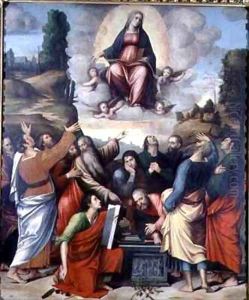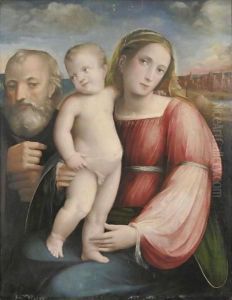Giacomo & Giulio Francia Paintings
Giacomo Francia and Giulio Francia, also known as Jacopo and Giulio Raibolini, were Italian painters of the Renaissance period, and sons of Francesco Raibolini, who was known as Francesco Francia. They were part of an artistic family workshop that was quite successful in Bologna, Italy. Giacomo was born in 1484 or 1486, and Giulio's birthdate is less clear, but it is known that they were working in the sixteenth century.
Francesco Francia, their father, was a prominent painter and goldsmith. He was one of the most respected artists in Bologna, and his workshop produced many religious works, including altarpieces, paintings, and medals. Under their father's guidance, Giacomo and Giulio learned painting and goldsmithing. After Francesco's death in 1517, the brothers took over the workshop and continued the artistic legacy of their family.
While Giacomo and Giulio often worked together, it is sometimes difficult to distinguish their individual contributions to their collaborative works. However, their style is noted for continuing the gentle and devout characteristics of their father's art. They managed to maintain the prestige of the Francia workshop through commissions from local religious institutions and private patrons.
Giacomo is believed to have been the more prominent of the two brothers and is credited with maintaining the workshop's high standards. His works reflect a blend of his father's influence and the evolving Renaissance styles. Giulio, on the other hand, was also a talented artist, but his individual works are less documented, and as such, his personal style is not as well known as that of his brother or his father.
Giacomo Francia's death is recorded in 1557, while Giulio is believed to have lived much longer, with some sources suggesting he continued working until his death in 1628. This long lifespan, if accurate, would have allowed him to witness the transition from the High Renaissance into the Mannerist and early Baroque periods.
The Francia brothers' works can be found in various churches and museums, and they are remembered for their contributions to the Bologna school of painting, which was characterized by its devotion to religious themes, its harmonious use of color, and its combination of Lombard naturalism with the monumental forms of the Roman school.

